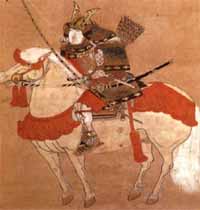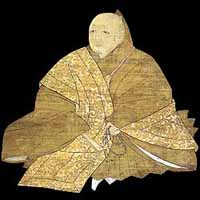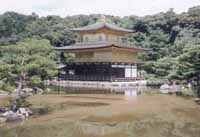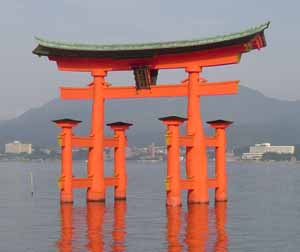Muromachi Period1338-1573 |
|
||||||||||||||||||||||||||||||||||||||||||||||||||||||||||||||||||||||||||||||||||||||||||||||||||
ASHIKAGA TAKAUJI | ASHIKAGA YOSHIMITSU | THE GOLDEN PAVILLION | LITERATURE | |THE SILVER PAVILLION | THE NOH DRAMA | ITSUKUSHIMA SHRINE | THE ONIN WAR
 This
time period revolves around the shogunate of the Ashikaga family. Ashikaga
Takauji (at left) is one of the most controversial men in Japanese history.
The tale of his controversy and the beginning of the period begin with Emperor
Go-Daigo and his preparation to end the shogun
rule in Kamakura rule. In order to do this he needed Takauji's assistance.
Due to his power and large land holding, Takauji was sent after news of Go-Daigo's
rebellion reached Kamakura. He was part of the assault that ended with the
capture of the emperor. Emperor Go-Daigo was placed on Oki Island in exile.
In 1333, he escaped. Again Takauji was ordered to take samurai
to put down the emperor. However, after receiving a letter from the emperor,
he decided to declare himself and his troops in support of the emperor and
attacked Kyoto in June. By July 1333, Emperor Go-Daigo was again on the throne
in Kyoto. Despite his loyalty, Takauji was not granted the title shogun as
expected. After being branded at traitor by Emperor Go-Daigo, Takauji turned
to Emperor Kogon-in, who had been appointed in 1331 by the Hojo Clan. With
Kogon-in's support, Takauji battled with Emperor Go-Daigo until he retreated
from Kyoto, beginning the Southern Court while Kogon-in began the Northern
Court and appointed him Shogun in 1338. When he eventually attained the title
of shogun, Takauji sent up his headquarters
in the Muromachi section of Kyoto. Takauji remained in control of the shogunate
until his death in 1358. The Muromachi period begins with his taking the title
of shogun and is named after the section
of Kyoto where his headquarters were located. As for the two courts, they
existed simultaneously for 50 years until the southern court gave in leading
to one emperor.
This
time period revolves around the shogunate of the Ashikaga family. Ashikaga
Takauji (at left) is one of the most controversial men in Japanese history.
The tale of his controversy and the beginning of the period begin with Emperor
Go-Daigo and his preparation to end the shogun
rule in Kamakura rule. In order to do this he needed Takauji's assistance.
Due to his power and large land holding, Takauji was sent after news of Go-Daigo's
rebellion reached Kamakura. He was part of the assault that ended with the
capture of the emperor. Emperor Go-Daigo was placed on Oki Island in exile.
In 1333, he escaped. Again Takauji was ordered to take samurai
to put down the emperor. However, after receiving a letter from the emperor,
he decided to declare himself and his troops in support of the emperor and
attacked Kyoto in June. By July 1333, Emperor Go-Daigo was again on the throne
in Kyoto. Despite his loyalty, Takauji was not granted the title shogun as
expected. After being branded at traitor by Emperor Go-Daigo, Takauji turned
to Emperor Kogon-in, who had been appointed in 1331 by the Hojo Clan. With
Kogon-in's support, Takauji battled with Emperor Go-Daigo until he retreated
from Kyoto, beginning the Southern Court while Kogon-in began the Northern
Court and appointed him Shogun in 1338. When he eventually attained the title
of shogun, Takauji sent up his headquarters
in the Muromachi section of Kyoto. Takauji remained in control of the shogunate
until his death in 1358. The Muromachi period begins with his taking the title
of shogun and is named after the section
of Kyoto where his headquarters were located. As for the two courts, they
existed simultaneously for 50 years until the southern court gave in leading
to one emperor. 
During the 1360's Kyoto faced many difficult natural disasters. In 1361, earthquake plagues Kyoto. This natural disaster, a common one in Japan was followed by a drought and famine in 1362. Kyoto had later difficulties in 1366, and three more times in the 1370's with epidemics. It was during this time period that another important leader emerged. Shogun Ashikaga Yoshimitsu (at right) was the grandson of Takauji and the third shogun of the Muromachi Period. Among his many credits is the uniting of the Northern and Southern Court in 1392. This one event firmly establish the authority of the Muromachi shogunate. Yoshimitsu also established trade relations with the Ming Dynasty in China. This led to new markets and new social classes. One group that emerged was the military families. They were able to influence entire provinces. These new feudal lords were called daimyo. In 1397 Ashikaga Yoshimitsu retired, letting his son, Yoshimochi assume the title of shogun but did not truly relinquish influence until he died in 1408.
 The
Golden Pavilion was remodeled in 1397 by Ashikaga Yoshimitusu as a retirement
retreat where he planned to become a monk. Originally built in the Kamakura
Period, it reflects three different styles of architecture. The first floor
reflects Heian architecture, the second Kamakura architecture and the third
Muromachi architecture. The major type of Muromachi architecture seen at the
Golden Pavilion is shoin or study. It became the preferred style of feudal
lords for their reading rooms. When Yoshimitusu died in 1408, it became a
Zen temple and was renamed Kinkakuji. In 1467 and 1567 the temple was destroyed
and rebuilt. Sadly it was again destroyed in 1950 this time by fire and a
student monk. It was rebuilt to be the temple seen at left in 1955. The name
Golden Pavilion comes from the second and third stories which are gilded with
gold which in 1987 were made to be five times thicker than the original temple.
The Pavilion was designed to be surrounded by gardens which still exist today.
Click here to see a guide to Buddhist Temples.
The
Golden Pavilion was remodeled in 1397 by Ashikaga Yoshimitusu as a retirement
retreat where he planned to become a monk. Originally built in the Kamakura
Period, it reflects three different styles of architecture. The first floor
reflects Heian architecture, the second Kamakura architecture and the third
Muromachi architecture. The major type of Muromachi architecture seen at the
Golden Pavilion is shoin or study. It became the preferred style of feudal
lords for their reading rooms. When Yoshimitusu died in 1408, it became a
Zen temple and was renamed Kinkakuji. In 1467 and 1567 the temple was destroyed
and rebuilt. Sadly it was again destroyed in 1950 this time by fire and a
student monk. It was rebuilt to be the temple seen at left in 1955. The name
Golden Pavilion comes from the second and third stories which are gilded with
gold which in 1987 were made to be five times thicker than the original temple.
The Pavilion was designed to be surrounded by gardens which still exist today.
Click here to see a guide to Buddhist Temples.
Although the Muromachi Period is known for its military conflicts and intrigue, several important pieces of literature were produced. The first of these was Tsurezuregusa or Essays in Idleness by Kenko Yohsido. Similar to The Pillow Book, it has a regretful mood that is attributed to the time period. Most popular during this time period were otogizoshi, or collections of popular short stories by a variety of unknown authors. Poetry also flourished during this time period. In 1439, the last twenty-one imperial anthologies of poetry were collected. Renga or linked verse was created in the early 1300's. In renga, three or more poets would compose one long poem. The stanzas would alternate from a three line stanza of the seven syllable, five syllable, and seven syllable meter to a two lined stanza with seven syllable meter in both lines. In 1488, three masters of renga, Sogi, Shohaku, and Socho composed Minase Sangin or Three Poets at Minase. Historically during this time period a work depicting the struggle over the two courts was written. The Taiheiki or The Chronicle of the Great Peace relates the years from 1318 to 1367 when the two courts were struggling for power.
 The
other famous structure of this time period is the Silver Pavilion or Ginkaku-ji(pictured
at right). Completed in 1484 for Yoshimasa, the Eighth Ashikaga Shogun and
grandson of Yoshimitsu who built the Golden Pavilion Much like the Golden
Pavilion, it was built for Yoshimasa's retirement and personal place of Buddhist
worship. It too became part of a Zen Buddhist temple in 1490 when he died.
Through civil unrest all but two structures were destroyed. The first floor
of the building can be divided into smaller spaces with wood and paper screens
and contains images of Jizo, the protector of children. The second floor is
dedicated to Kannon and often called the Kannon Hall. Similar to the Golden
Pavilion, the Silver Pavilion was to be leafed in its namesake medal, but
was never gilded. Much like the Golden Pavilion it is surrounded by large
gardens which hosted many tea ceremonies and Noh plays. Click
here to see a guide to Buddhist Temples.
The
other famous structure of this time period is the Silver Pavilion or Ginkaku-ji(pictured
at right). Completed in 1484 for Yoshimasa, the Eighth Ashikaga Shogun and
grandson of Yoshimitsu who built the Golden Pavilion Much like the Golden
Pavilion, it was built for Yoshimasa's retirement and personal place of Buddhist
worship. It too became part of a Zen Buddhist temple in 1490 when he died.
Through civil unrest all but two structures were destroyed. The first floor
of the building can be divided into smaller spaces with wood and paper screens
and contains images of Jizo, the protector of children. The second floor is
dedicated to Kannon and often called the Kannon Hall. Similar to the Golden
Pavilion, the Silver Pavilion was to be leafed in its namesake medal, but
was never gilded. Much like the Golden Pavilion it is surrounded by large
gardens which hosted many tea ceremonies and Noh plays. Click
here to see a guide to Buddhist Temples.
It is during this time period that noh dramas evolved. Noh is drama that contains dance, music, and poetry. WIth sponsorship from the upper class, traveling acting groups performed dramas at festivals and temples. Noh dramas usually include a hero who is often a ghost and try to express the passion of life. Noh has a specified stage design and specific props and masks that are used. The masks worn are often general like old or young man or woman. A traditional performance involving noh has five noh plays with three to four kyogen in between. Noh is usually has symbolic meaning while kyogen is comical in nature. The most famous Noh plays of this time were penned by a father and son team of writers, Kan’ami and Zeami. One play whose original author is unknown was revised by Zeami to become the most popular noh play. Aoi no Ue (Lady Aoi) was believed to be based on Tale of Genji by Murasaki Shikibu.
 Perhaps
one of the most famous shrines constructed during this period is located on
Miyajima. Itsukushima Shrine is most famous for it's red Otorii that rises
out of the waters of Hiroshima Bay. The shrine is located south of Hiroshima
on Miyajima Island. The earliest date for the main shrine is 593. The claim
is that the shrine was constructed by Saeki Kuramoto. The first written record
of Itsukushima Shrine is in the Nihon Koki (Notes on Japan) from 881. The
shrine gained importance when the Taira clan began to worship at the shrine.
Most of the buildings were constructed during the Heian period but due to
fires and other natural disasters, the main shrine that remains today was
built in 1571. Even though some buildings are older than the Heian period
and some are constructed after the period, the shrine is said to be an excellent
example of Heian Period architecture. As you approach the shrine by ferry
boat, you cannot help but see the awesome
Otorii. The present Otorii was constructed out of camphor in 1874 and
stands over 16 meters (over 35 feet) in height. The shrine is laid
out on the water and at high tide appears to be floating. It
is a series of buildings rather than just one building all built on underwater
pillars. There are two beliefs in the concept of building the shrine on the
water. The first is the attempt to build the Dragon Palace (Rygu-jo). The
second is to reinforce the concept that when people die, their soul crosses
over to the next world by boat. The goddess enshrined in at Itsukushima is
the goddess of the sea. From Hirabutai (Broad Stage) a dock projects toward
the red torii. At the end of the projected dock, there is Hitasaki
(Front Lantern). The Hirabutai is used during the Music Festival (Kangensai)
for the arrival and departure of the goddess. In the center of the Hirabutai
(Broad Stage) is the Takabutai (High Stage) which is used for Bugaku (ancient
Japanese musical court dance). The Broad Sage stands in front of Haiden (the
Main Worshipping Hall). There is also a side stage for noh performances. Due
to the modern day dangers, visitors do not approach the shrine through the
Otorii. Rather visitors take a ferry to the island and approach by land. Like
all shinto shrines, Itsukushima Shrine has a pair or guardian
lions at the land entrance. Click here to see
a guide to Shinto Shrines.
Perhaps
one of the most famous shrines constructed during this period is located on
Miyajima. Itsukushima Shrine is most famous for it's red Otorii that rises
out of the waters of Hiroshima Bay. The shrine is located south of Hiroshima
on Miyajima Island. The earliest date for the main shrine is 593. The claim
is that the shrine was constructed by Saeki Kuramoto. The first written record
of Itsukushima Shrine is in the Nihon Koki (Notes on Japan) from 881. The
shrine gained importance when the Taira clan began to worship at the shrine.
Most of the buildings were constructed during the Heian period but due to
fires and other natural disasters, the main shrine that remains today was
built in 1571. Even though some buildings are older than the Heian period
and some are constructed after the period, the shrine is said to be an excellent
example of Heian Period architecture. As you approach the shrine by ferry
boat, you cannot help but see the awesome
Otorii. The present Otorii was constructed out of camphor in 1874 and
stands over 16 meters (over 35 feet) in height. The shrine is laid
out on the water and at high tide appears to be floating. It
is a series of buildings rather than just one building all built on underwater
pillars. There are two beliefs in the concept of building the shrine on the
water. The first is the attempt to build the Dragon Palace (Rygu-jo). The
second is to reinforce the concept that when people die, their soul crosses
over to the next world by boat. The goddess enshrined in at Itsukushima is
the goddess of the sea. From Hirabutai (Broad Stage) a dock projects toward
the red torii. At the end of the projected dock, there is Hitasaki
(Front Lantern). The Hirabutai is used during the Music Festival (Kangensai)
for the arrival and departure of the goddess. In the center of the Hirabutai
(Broad Stage) is the Takabutai (High Stage) which is used for Bugaku (ancient
Japanese musical court dance). The Broad Sage stands in front of Haiden (the
Main Worshipping Hall). There is also a side stage for noh performances. Due
to the modern day dangers, visitors do not approach the shrine through the
Otorii. Rather visitors take a ferry to the island and approach by land. Like
all shinto shrines, Itsukushima Shrine has a pair or guardian
lions at the land entrance. Click here to see
a guide to Shinto Shrines.
The Muromachi Period is one that is known for its military
conflicts among the daimyo. With the
increase of power held by individual daimyo, internal problems increased.
The shogun of this time period were more focused on displaying their wealth
and concentrated on rites like the tea ceremony and flower arranging. Unhappiness
with the shoguns and lords led to a peasant uprising or tsuchi ikki in Kyoto
and its surrounding provinces in 1428. Years of internal problems led to the
Onin War from 1467 to 1477. The Onin War began as a power struggle between
to families the Hosokawa and the Yamana. This war destroyed parts of Kyoto
and killed thousands of Japanese. In the end the Hosokawa family prevailed
and controlled the Ashikaga shoguns. What followed were struggles over who
would retain control of the shogunate and the control of Japan. This brought
Japan into the Age of the Warring States. This time period is Japanese history
is called sengoku jidai. More accurately, the fighting was between individual
warlords. This continued until one man with the vision to unite Japan under
one sword rose to power, Oda Nobunaga. It is through him that the Muromachi
Period ends and Azuchi-Momoyama Period begins.
to return to Mrs. O'Donnell's Home Page.
"Maintained according to the Lakeland
Central School District Web Page Policies and Guidelines."
“Clicking on the above links will direct you to site(s) outside the
Lakeland Central School District and the Lakeland High School server. The
Lakeland Central School District is not responsible for contents on external
sites and servers, nor does the district endorse the sponsors or advertising
on these sites.” This site was designed and maintained by Maureen
O'Donnell, a teacher at Lakeland
High School.
July 2005 Created - |
Saturday, February 25, 2006
Last Revised -













